airbag MERCEDES-BENZ E-CLASS CABRIOLET 2012 Owners Manual
[x] Cancel search | Manufacturer: MERCEDES-BENZ, Model Year: 2012, Model line: E-CLASS CABRIOLET, Model: MERCEDES-BENZ E-CLASS CABRIOLET 2012Pages: 389, PDF Size: 9.32 MB
Page 7 of 389
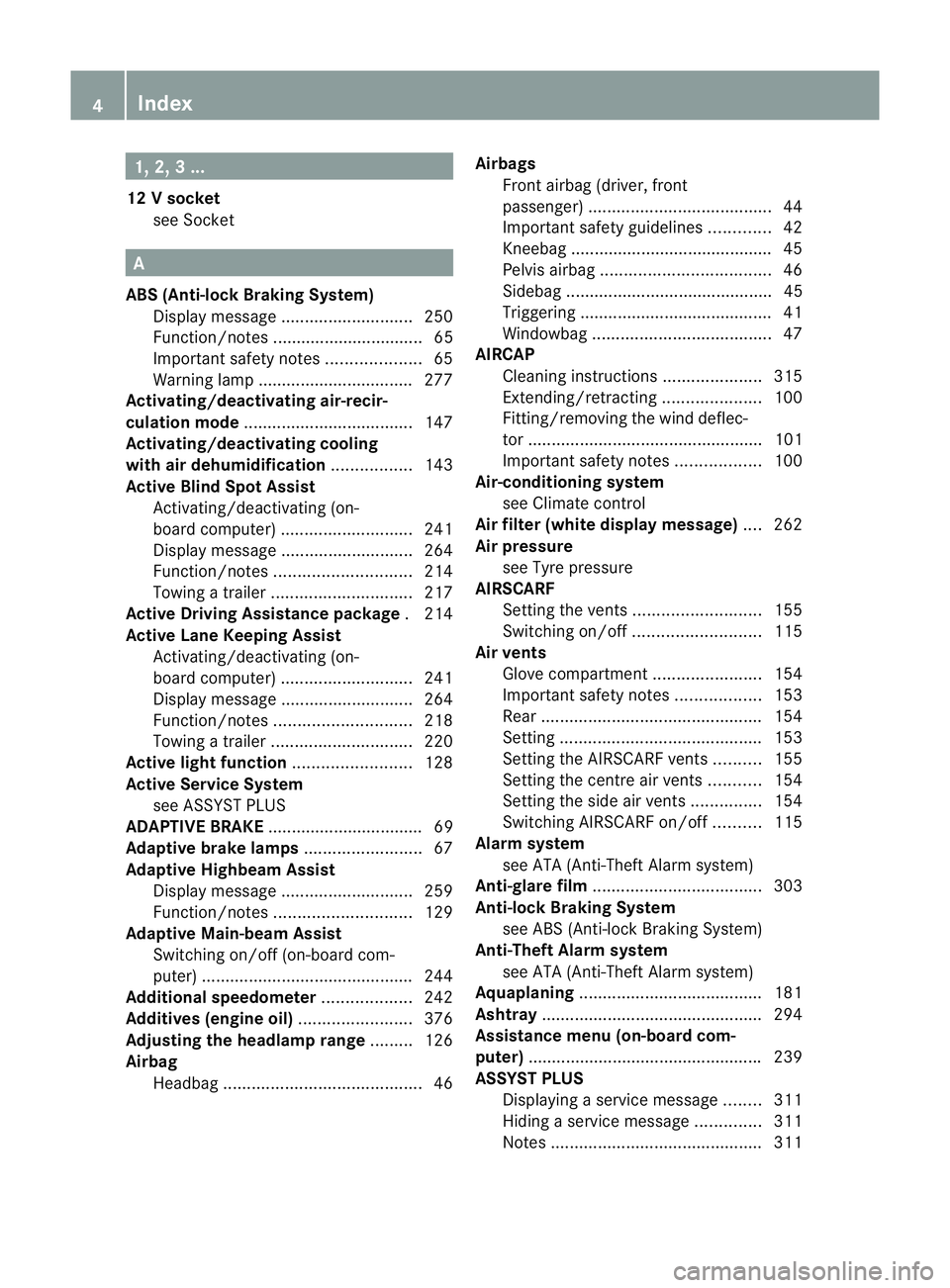
1, 2, 3 ...
12 Vsocket
see Socket A
ABS (Anti-lock Braking System) Display message ............................ 250
Function/notes ................................ 65
Important safety notes ....................65
Warning lamp ................................. 277
Activating/deactivating air-recir-
culation mode .................................... 147
Activating/deactivating cooling
with air dehumidification .................143
Active Blin dSpot Assist
Activating/deactivating (on-
board computer) ............................ 241
Display message ............................ 264
Function/notes ............................. 214
Towing atrailer .............................. 217
Active Driving Assistance package .214
Active Lane Keeping Assist Activating/deactivating (on-
board computer) ............................ 241
Display message ............................ 264
Function/notes ............................. 218
Towing atrailer .............................. 220
Active light function .........................128
Active Service System see ASSYST PLUS
ADAPTIVE BRAKE ................................. 69
Adaptive brake lamps .........................67
Adaptive Highbeam Assist Display message ............................ 259
Function/notes ............................. 129
Adaptive Main-beam Assist
Switching on/off (on-board com-
puter) ............................................. 244
Additional speedometer ...................242
Additives (engine oil) ........................376
Adjusting the headlamp range .........126
Airbag Headbag .......................................... 46Airbags
Front airbag (driver, front
passenger )....................................... 44
Important safety guidelines .............42
Kneebag .......................................... .45
Pelvis airbag .................................... 46
Sidebag ............................................ 45
Triggering ......................................... 41
Windowba g...................................... 47
AIRCAP
Cleaning instructions .....................315
Extending/retracting .....................100
Fitting/removing the wind deflec-
tor .................................................. 101
Important safety notes ..................100
Air-conditioning system
see Climate control
Airf ilter (white display message) ....262
Air pressure see Tyre pressure
AIRSCARF
Setting the vents ........................... 155
Switching on/off ........................... 115
Airv ents
Glove compartmen t....................... 154
Important safety notes ..................153
Rea r............................................... 154
Setting ........................................... 153
Setting the AIRSCARF vents ..........155
Setting the centre air vents ...........154
Setting the side air vents ...............154
Switching AIRSCARF on/off ..........115
Alarm system
see ATA (Anti-Theft Alarm system)
Anti-glare film .................................... 303
Anti-loc kBraking System
see ABS (Anti-lock Braking System)
Anti-Theft Alarm system
see ATA (Anti-Theft Alarm system)
Aquaplaning ....................................... 181
Ashtray ............................................... 294
Assistance menu (on-board com-
puter) ................................................. .239
ASSYST PLUS Displaying a service message ........311
Hiding a service message ..............311
Notes ............................................. 3114
Index
Page 18 of 389
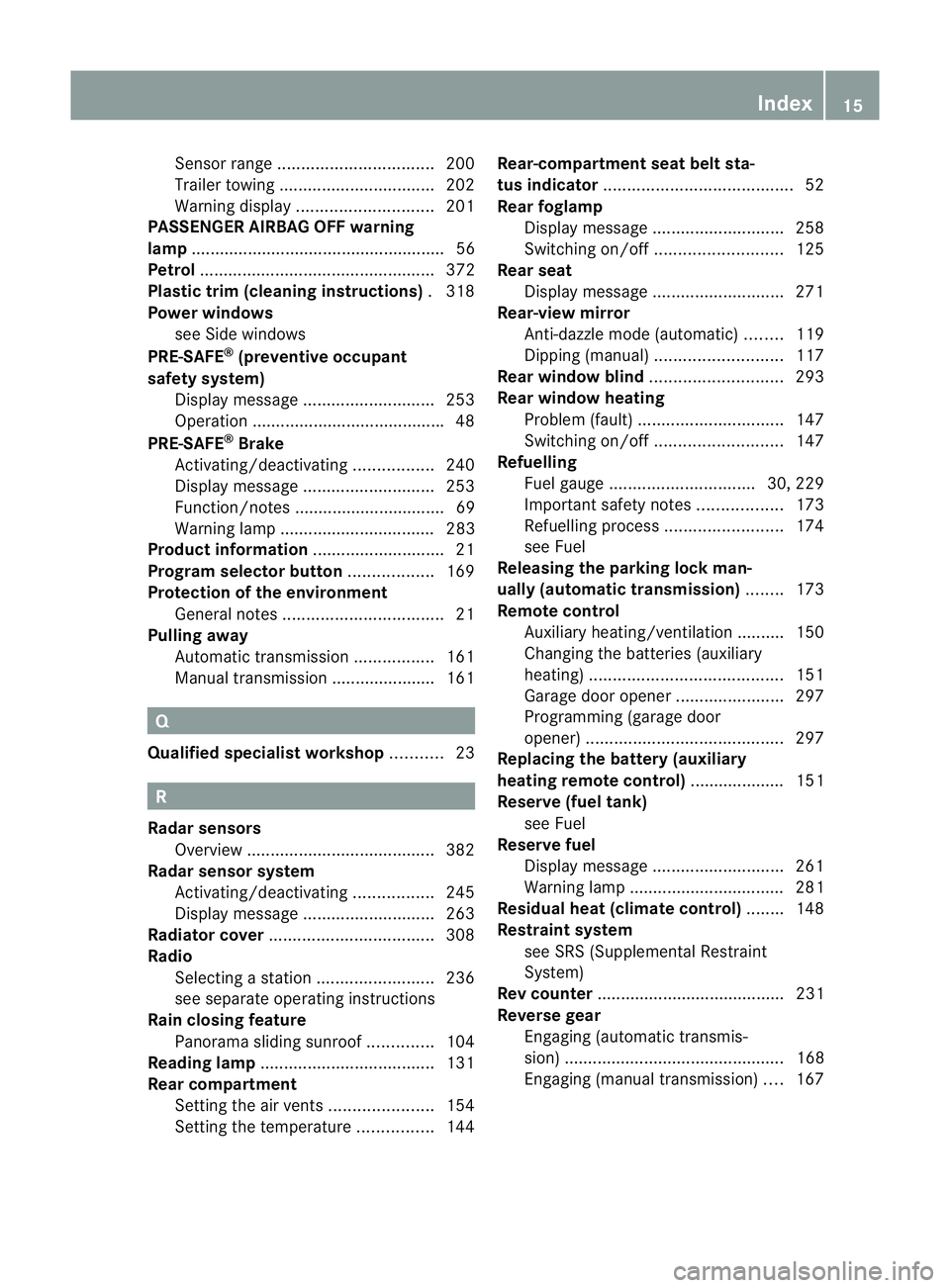
Senso
rrang e................................. 200
Trailer towing ................................. 202
Warning displa y............................. 201
PASSENGE RAIRBAG OFF warning
lamp ...................................................... 56
Petrol .................................................. 372
Plastic trim (cleaning instructions) .318
Power windows see Side windows
PRE-SAFE ®
(preventive occupant
safety system) Display message ............................ 253
Operation ........................................ .48
PRE-SAFE ®
Brake
Activating/deactivating .................240
Display message ............................ 253
Function/notes ................................ 69
Warning lamp ................................. 283
Product information ............................21
Program selector button ..................169
Protection of the environment General notes .................................. 21
Pulling away
Automatic transmission .................161
Manual transmission ..................... .161 Q
Qualifie dspecialis tworkshop ...........23 R
Radar sensors Overview ........................................ 382
Radar sensor system
Activating/deactivating .................245
Display message ............................ 263
Radiator cover ................................... 308
Radio Selecting astation ......................... 236
see separate operating instructions
Rain closing feature
Panorama sliding sunroo f.............. 104
Reading lamp ..................................... 131
Rear compartment Setting the airv ents...................... 154
Setting the temperature ................144Rear-compartment seat belt sta-
tus indicator
........................................ 52
Rear foglamp Display message ............................ 258
Switching on/off ........................... 125
Rear seat
Display message ............................ 271
Rear-view mirror
Anti-dazzle mode (automatic) ........119
Dipping (manual) ........................... 117
Rear window blind ............................293
Rear window heating Problem (fault) ............................... 147
Switching on/off ........................... 147
Refuelling
Fuel gauge ............................... 30, 229
Important safety notes ..................173
Refuelling proces s......................... 174
see Fuel
Releasing the parking loc kman-
ually (automatic transmission) ........173
Remote control Auxiliary heating/ventilation .......... 150
Changing the batteries (auxiliary
heating) ......................................... 151
Garage door opener .......................297
Programming (garage door
opener) .......................................... 297
Replacing the battery (auxiliary
heating remote control) .................... 151
Reserve (fuel tank) see Fuel
Reserve fuel
Display message ............................ 261
Warning lamp ................................. 281
Residual heat (climate control) ........148
Restraint system see SRS (Supplemental Restraint
System)
Rev counter ........................................ 231
Reverse gear Engaging (automatic transmis-
sion) ............................................... 168
Engaging (manual transmission) ....167 Index
15
Page 23 of 389
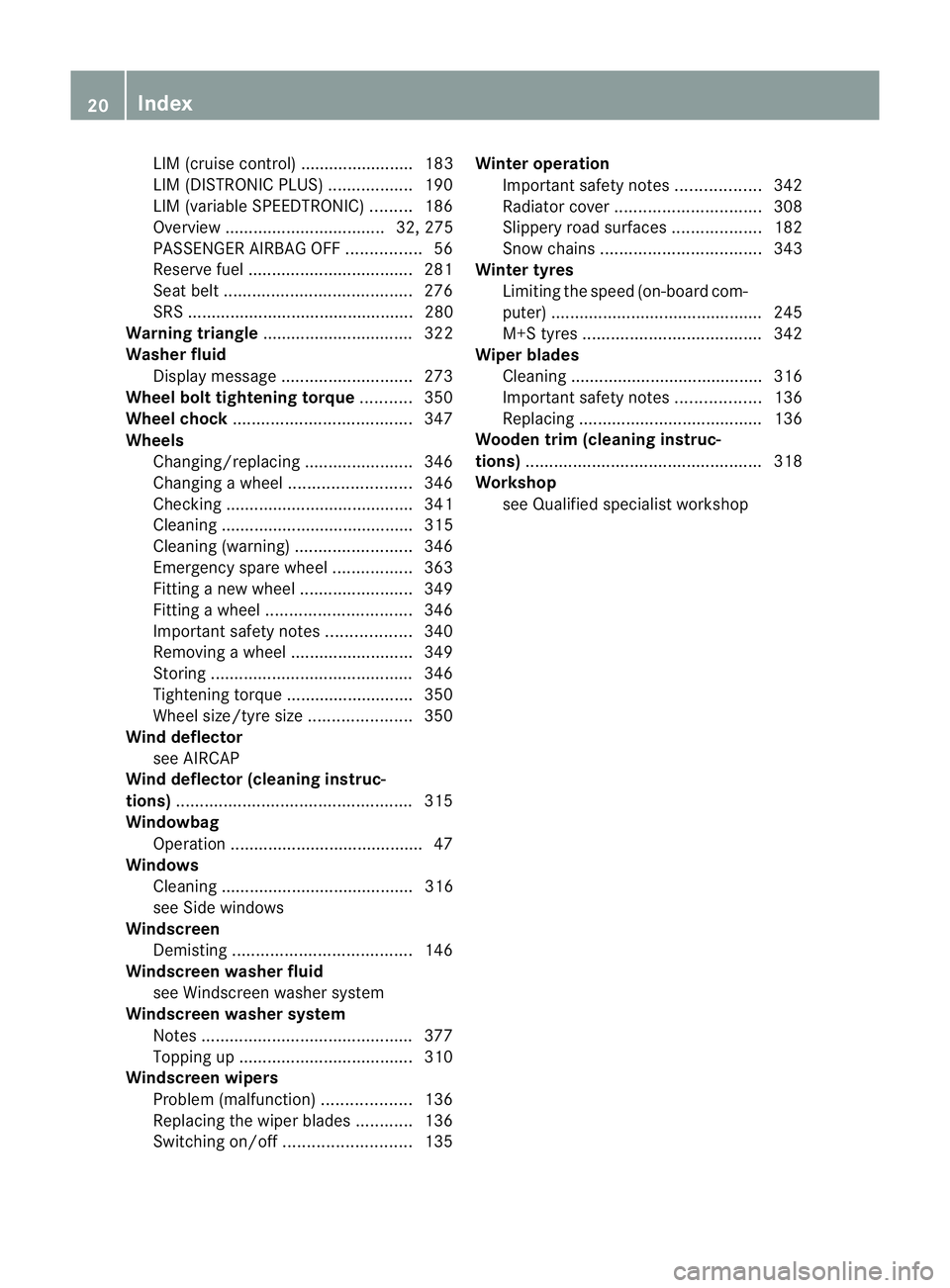
LIM (cruise control) ........................ 183
LIM (DISTRONIC PLUS)
..................190
LIM (variable SPEEDTRONIC) .........186
Overview .................................. 32, 275
PASSENGER AIRBAG OFF ................56
Reserve fuel ................................... 281
Seat bel t........................................ 276
SRS ................................................ 280
Warning triangle ................................ 322
Washer fluid Display message ............................ 273
Wheel bol ttightening torque ...........350
Wheel chock ...................................... 347
Wheels Changing/replacing .......................346
Changing awheel .......................... 346
Checking ........................................ 341
Cleaning ......................................... 315
Cleaning (warning) .........................346
Emergency spare wheel .................363
Fitting anew wheel ........................ 349
Fitting awheel ............................... 346
Important safety notes ..................340
Removing awheel .......................... 349
Storing ........................................... 346
Tightening torque ........................... 350
Whee lsize/tyre size ...................... 350
Wind deflector
see AIRCAP
Wind deflector (cleaning instruc-
tions) .................................................. 315
Windowbag Operation ........................................ .47
Windows
Cleaning ......................................... 316
see Side windows
Windscreen
Demisting ...................................... 146
Windscreen washe rfluid
see Windscreen washer system
Windscreen washer system
Notes ............................................. 377
Topping up ..................................... 310
Windscreen wipers
Problem (malfunction) ...................136
Replacing the wiper blades ............136
Switching on/off ........................... 135Winter operation
Important safety notes ..................342
Radiator cover ............................... 308
Slippery road surfaces ...................182
Snow chains .................................. 343
Winter tyres
Limiting the speed (on-board com-
puter) ............................................. 245
M+S tyres ...................................... 342
Wiper blades
Cleaning ......................................... 316
Important safety notes ..................136
Replacing ....................................... 136
Wooden trim (cleaning instruc-
tions) .................................................. 318
Workshop see Qualified specialist workshop 20
Index
Page 27 of 389
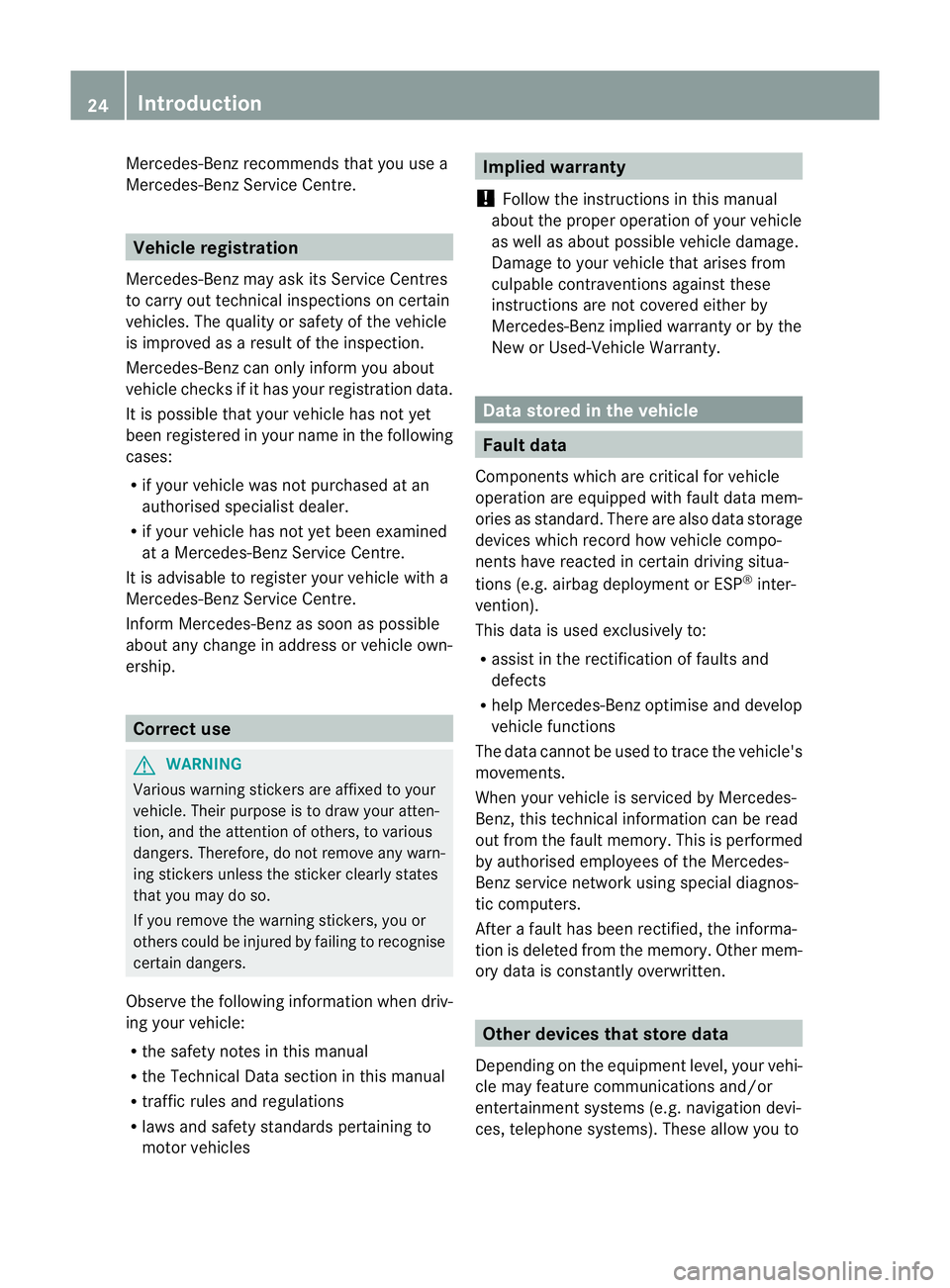
Mercedes-Ben
zrecommends that you use a
Mercedes-Benz Service Centre. Vehicle registration
Mercedes-Benz may ask its Service Centres
to carry out technical inspections on certain
vehicles. The quality or safety of the vehicle
is improved as a result of the inspection.
Mercedes-Benzc an only inform you about
vehicle checks if it has your registration data.
It is possible that your vehicle has no tyet
been registered in your name in the following
cases:
R if your vehicle was not purchased at an
authorised specialist dealer.
R if your vehicle has not yet been examined
at a Mercedes-Benz Service Centre.
It is advisable to register your vehicle with a
Mercedes-Benz Service Centre.
Inform Mercedes-Benza s soon as possible
abouta ny change in address or vehicle own-
ership. Correc
tuse G
WARNING
Various warning stickers are affixed to your
vehicle. Their purpose is to draw your atten-
tion, and the attention of others, to various
dangers. Therefore, do not remove any warn-
ing stickers unless the sticker clearly states
that you may do so.
If you remove the warning stickers, you or
others could be injured by failing to recognise
certain dangers.
Observe the following information when driv-
ing your vehicle:
R the safety notes in this manual
R the Technical Data section in this manual
R traffic rules and regulations
R laws and safety standards pertaining to
motor vehicles Implied warranty
! Follow the instructions in this manual
about the proper operation of your vehicle
as well as about possible vehicle damage.
Damage to your vehicle that arises from
culpable contraventions against these
instructions are not covered either by
Mercedes-Benz implied warranty or by the
New or Used-Vehicle Warranty. Data stored in the vehicle
Fault data
Components which are critical for vehicle
operation are equipped with fault data mem-
ories as standard. There are also data storage
devices which record how vehicle compo-
nents have reacted in certain driving situa-
tions (e.g. airbag deployment or ESP ®
inter-
vention).
This data is used exclusively to:
R assist in the rectification of faults and
defects
R help Mercedes-Benz optimise and develop
vehicle functions
The data cannot be used to trace the vehicle's
movements.
When your vehicle is serviced by Mercedes-
Benz, this technical information can be read
out from the fault memory. This is performed
by authorised employees of the Mercedes-
Benz service network using special diagnos-
tic computers.
After a fault has been rectified, the informa-
tion is deleted from the memory. Other mem-
ory data is constantly overwritten. Other devices that store data
Depending on the equipment level, your vehi-
cle may feature communications and/or
entertainment systems (e.g. navigation devi-
ces, telephone systems). These allow you to 24
Introduction
Page 37 of 389
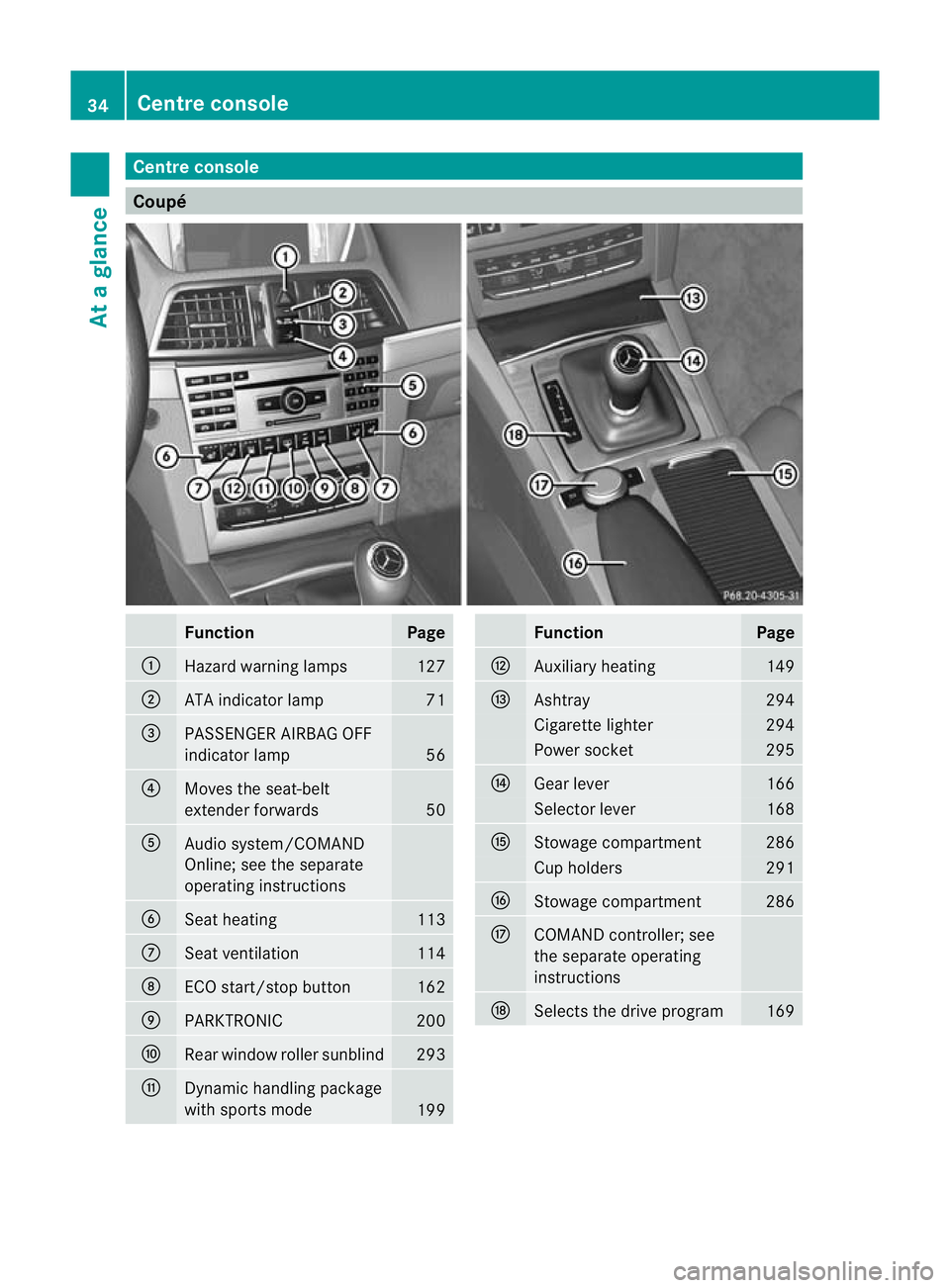
Centre console
Coupé
Function Page
:
Hazard warning lamps 127
;
ATA indicator lamp 71
=
PASSENGER AIRBAG OFF
indicator lamp
56
?
Moves the seat-belt
extender forwards
50
A
Audio system/COMAND
Online; see the separate
operating instructions
B
Seat heating 113
C
Seat ventilation 114
D
ECO start/stop button 162
E
PARKTRONIC 200
F
Rear window roller sunblind 293
G
Dynamic handling package
with sports mode
199 Function Page
H
Auxiliary heating 149
I
Ashtray 294
Cigarette lighter 294
Power socket 295
J
Gear lever 166
Selector lever 168
K
Stowage compartment 286
Cup holders 291
L
Stowage compartment 286
M
COMAND controller; see
the separate operating
instructions N
Selects the drive program 16934
Centre consoleAt a glance
Page 38 of 389
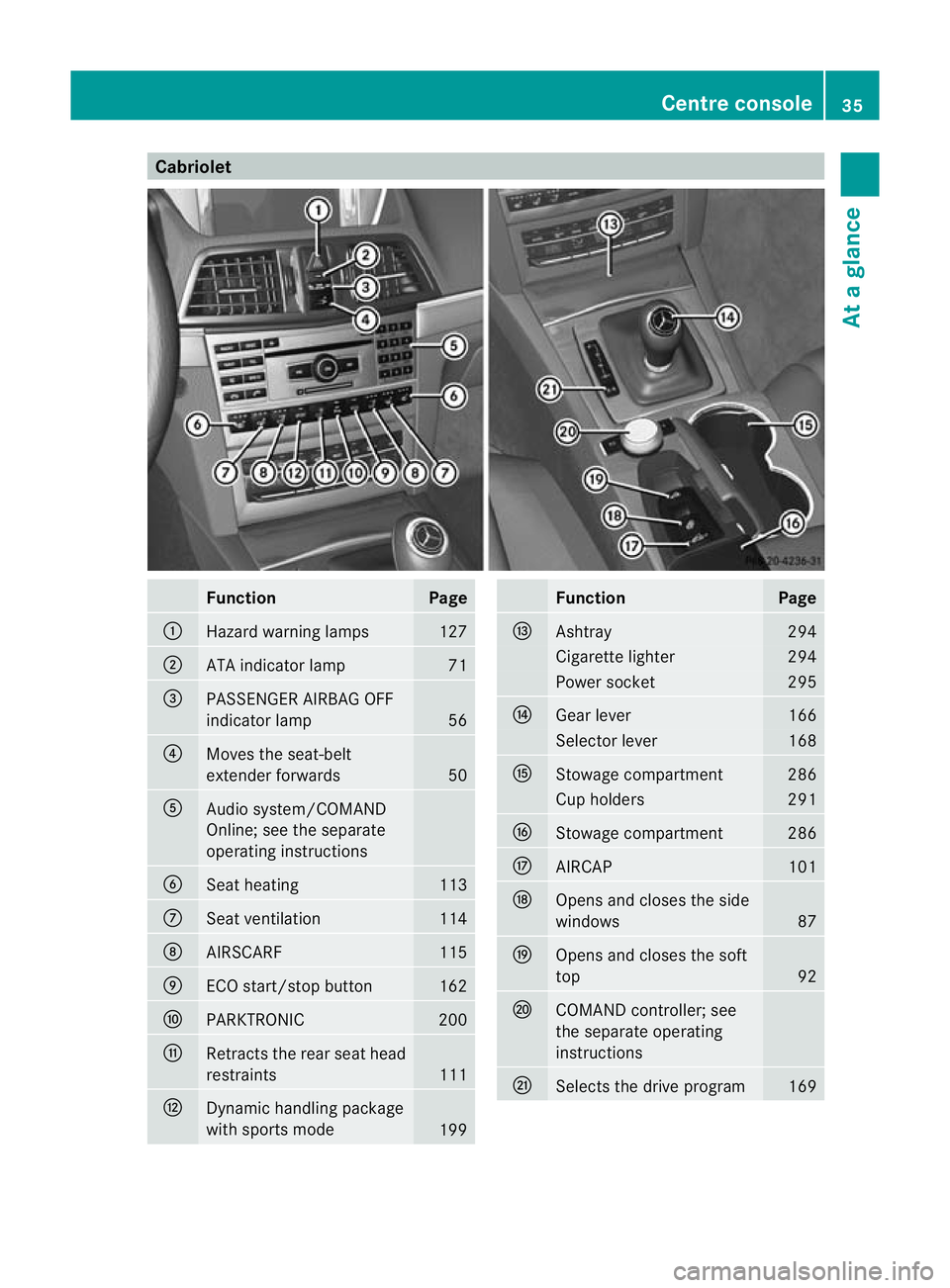
Cabriolet
Function Page
:
Hazard warning lamps 127
;
ATA indicator lamp 71
=
PASSENGER AIRBAG OFF
indicator lamp
56
?
Moves the seat-belt
extender forwards
50
A
Audio system/COMAND
Online; see the separate
operating instructions
B
Seat heating 113
C
Seat ventilation 114
D
AIRSCARF 115
E
ECO start/stop button 162
F
PARKTRONIC 200
G
Retracts the rear seat head
restraints
111
H
Dynamic handling package
with sports mode
199 Function Page
I
Ashtray 294
Cigarette lighter 294
Power socket 295
J
Gear lever 166
Selector lever 168
K
Stowage compartment 286
Cup holders 291
L
Stowage compartment 286
M
AIRCAP 101
N
Opens and closes the side
windows
87
O
Opens and closes the soft
top
92
P
COMAND controller; see
the separate operating
instructions
Q
Selects the drive program 169Centre console
35At a glance
Page 43 of 389
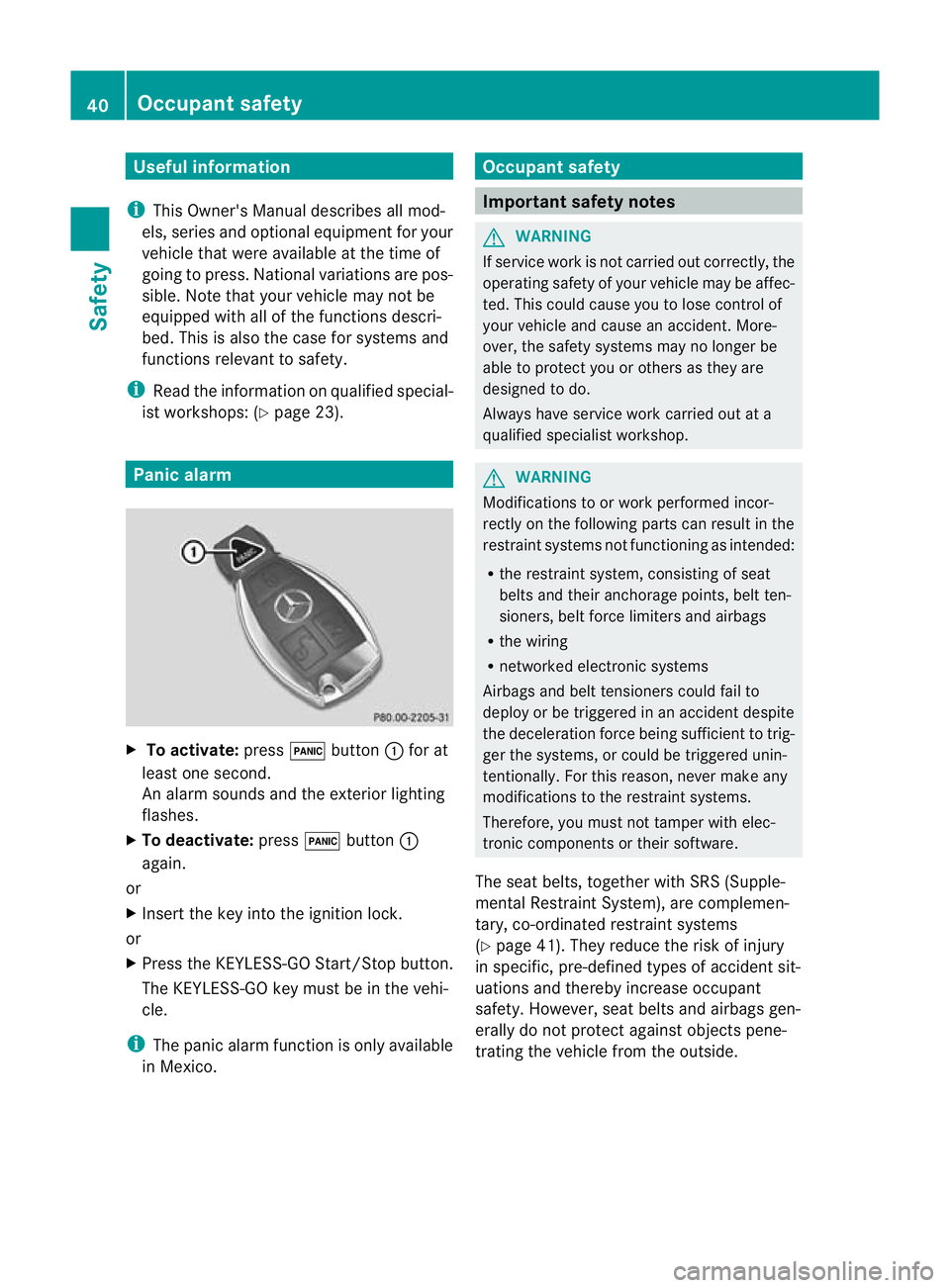
Useful information
i This Owner's Manual describes all mod-
els, series and optional equipment for your
vehicle that were available at the time of
going to press. National variations are pos-
sible. Note that your vehicle may not be
equipped with all of the functions descri-
bed. This is also the case for systems and
functions relevant to safety.
i Read the information on qualified special-
ist workshops: (Y page 23). Panic alarm
X
To activate: press!button :for at
least one second.
An alarm sounds and the exterior lighting
flashes.
X To deactivate: press!button :
again.
or
X Insert the key into the ignition lock.
or
X Press the KEYLESS-GO Start/Stop button.
The KEYLESS-GO key must be in the vehi-
cle.
i The panic alarm function is only available
in Mexico. Occupant safety
Important safety notes
G
WARNING
If service work is not carried out correctly, the
operating safety of your vehicle may be affec-
ted. This could cause you to lose control of
your vehicle and cause an accident. More-
over, the safety system smay no longer be
able to protect you or others as they are
designed to do.
Always have service work carried out at a
qualified specialist workshop. G
WARNING
Modifications to or work performed incor-
rectly on the following parts can result in the
restraint systems no tfunctioning as intended:
R the restraint system, consisting of seat
belts and their anchorage points, belt ten-
sioners, belt force limiters and airbags
R the wiring
R networked electronic systems
Airbags and belt tensioners could fail to
deploy or be triggered in an acciden tdespite
the deceleration force being sufficien tto trig-
ger the systems, or could be triggered unin-
tentionally. For this reason, never make any
modifications to the restraint systems.
Therefore, you must not tamper with elec-
tronic components or their software.
The seat belts, together with SRS (Supple-
mental Restraint System), are complemen-
tary, co-ordinated restraint systems
(Y page 41). They reduce the risk of injury
in specific, pre-defined types of accident sit-
uations and thereby increase occupant
safety. However, seat belts and airbags gen-
erally do not protect against objects pene-
trating the vehicle from the outside. 40
Occupant safetySafety
Page 44 of 389
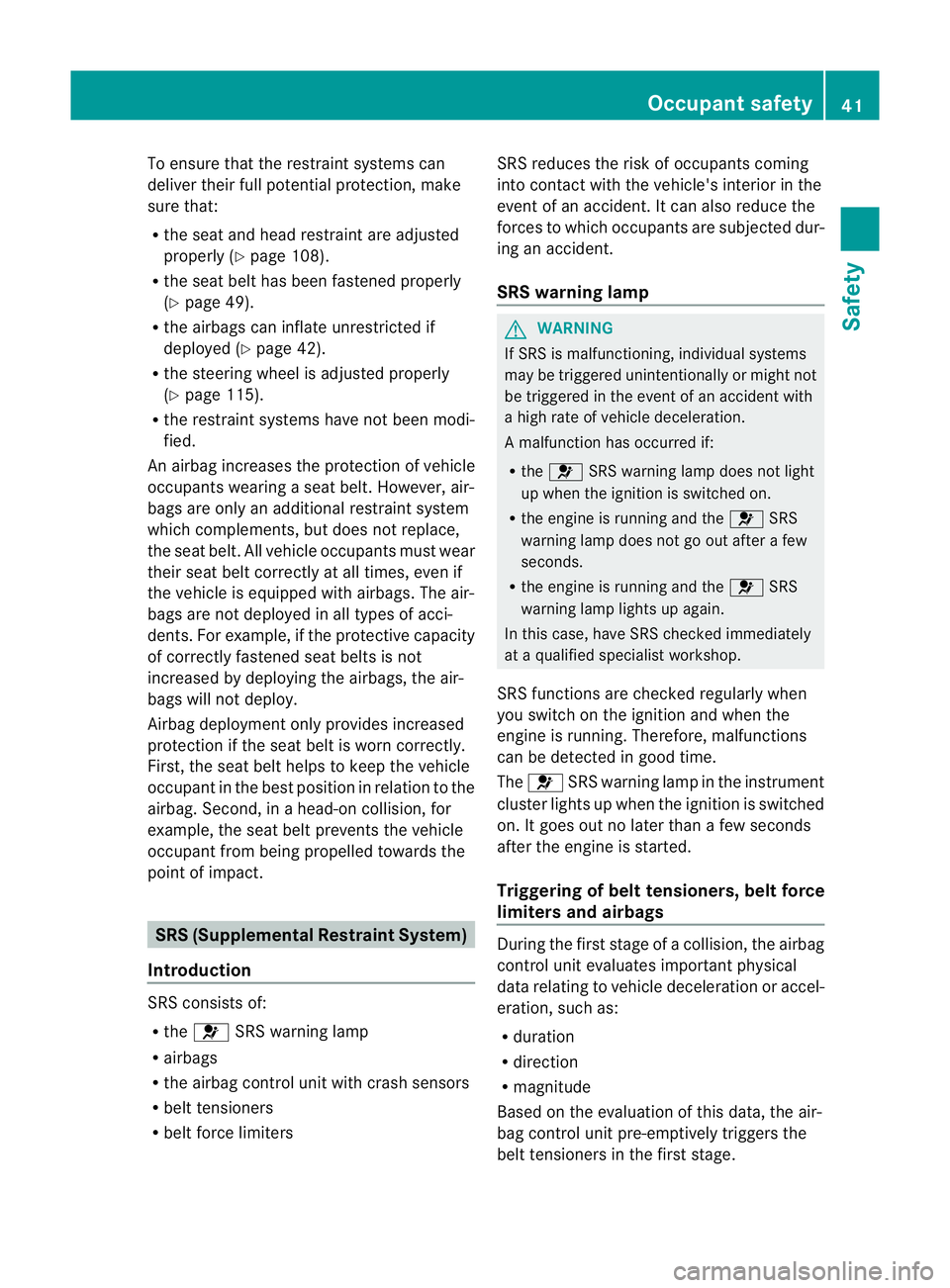
To ensure that the restraint systems can
deliver their full potential protection, make
sure that:
R the seat and head restraint are adjusted
properly (Y page 108).
R the seat belt has been fastened properly
(Y page 49).
R the airbags can inflate unrestricted if
deployed (Y page 42).
R the steering wheel is adjusted properly
(Y page 115).
R the restraint systems have not been modi-
fied.
An airbag increases the protection of vehicle
occupants wearing a seat belt. However, air-
bags are only an additional restraint system
which complements, but does not replace,
the seat belt. All vehicle occupants must wear
their seat belt correctly at all times, even if
the vehicle is equipped with airbags. The air-
bags are not deployed in all types of acci-
dents .For example, if the protective capacity
of correctly fastened seat belts is not
increased by deploying the airbags, the air-
bags will not deploy.
Airbag deployment only provides increased
protection if the seat belt is worn correctly.
First, the seat belt helps to keep the vehicle
occupant in the best position in relation to the
airbag. Second, in a head-on collision, for
example, the seat belt prevents the vehicle
occupant from being propelled towards the
point of impact. SRS (Supplemental Restraint System)
Introduction SRS consists of:
R
the 6 SRS warning lamp
R airbags
R the airbag control unit with crash sensors
R belt tensioners
R belt force limiters SRS reduces the risk of occupants coming
into contact with the vehicle's interior in the
event of an accident. It can also reduce the
forces to which occupant
sare subjected dur-
ing an accident.
SRS warning lamp G
WARNING
If SRS is malfunctioning, individual systems
may be triggered unintentionally or might not
be triggered in the event of an accident with
a high rate of vehicle deceleration.
A malfunction has occurred if:
R the 6 SRS warning lamp does not light
up when the ignitio nis switched on.
R the engine is running and the 6SRS
warning lamp does not go out after a few
seconds.
R the engine is running and the 6SRS
warning lamp lights up again.
In this case, have SRS checked immediately
at a qualified specialist workshop.
SRS functions are checked regularly when
you switch on the ignition and when the
engine is running. Therefore, malfunctions
can be detected in good time.
The 6 SRS warning lamp in the instrument
cluster lights up when the ignition is switched
on. It goes out no later than a few seconds
after the engine is started.
Triggering of belt tensioners, belt force
limiters and airbags During the first stage of a collision, the airbag
control unit evaluates important physical
data relating to vehicle deceleration or accel-
eration, such as:
R
duration
R direction
R magnitude
Based on the evaluation of this data, the air-
bag control unit pre-emptively triggers the
belt tensioners in the first stage. Occupant safety
41Safety Z
Page 45 of 389
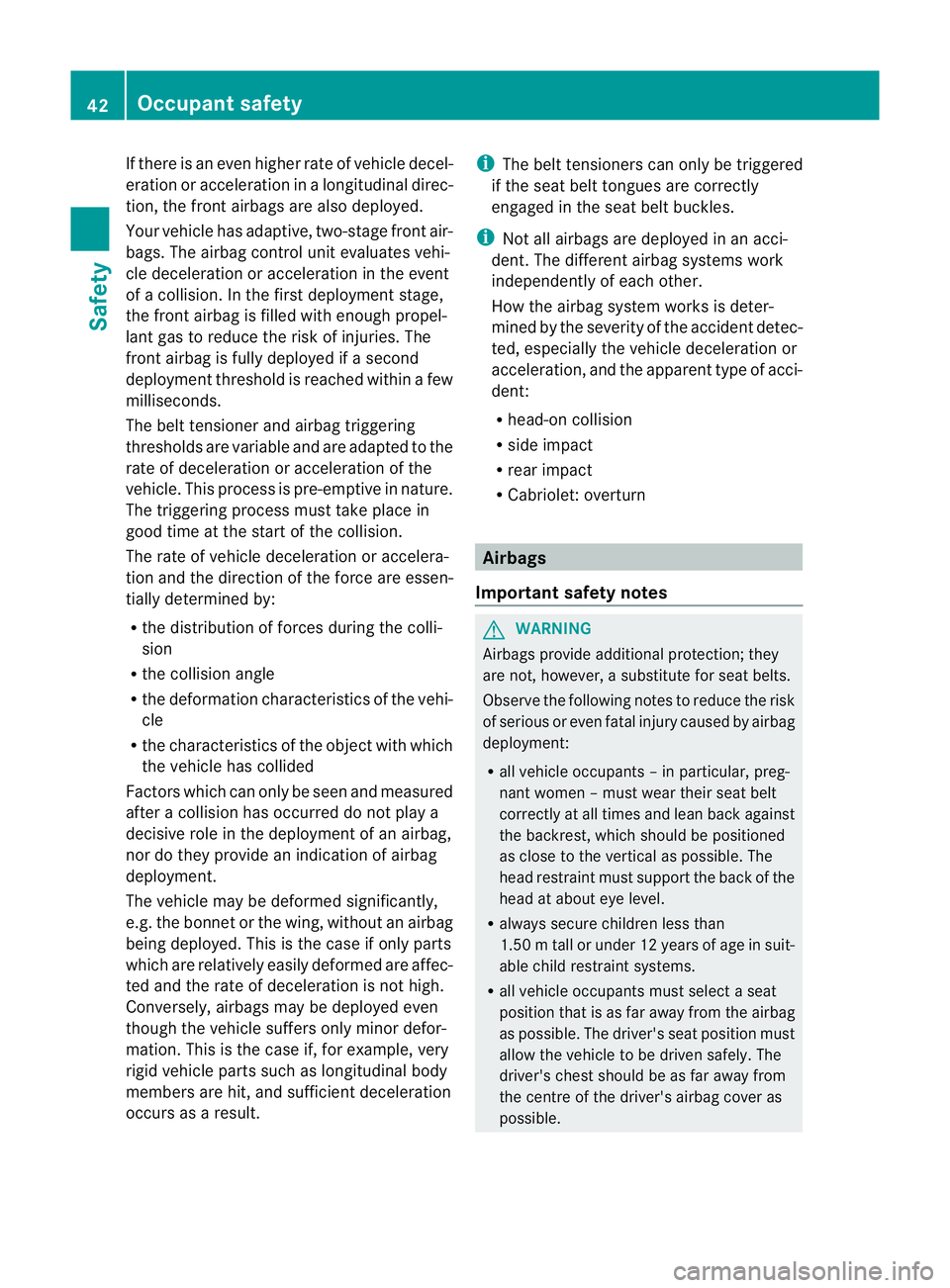
If there is an even higherr
ate of vehicle decel-
eration or acceleratio ninalongitudinal direc-
tion, the front airbags are also deployed.
Your vehicle has adaptive, two-stage front air-
bags. The airbag control unit evaluates vehi-
cle deceleration or acceleration in the event
of a collision. In the firs tdeployment stage,
the fron tairbag is filled with enough propel-
lant gas to reduce the risk of injuries. The
front airbag is fully deployed if a second
deploymen tthreshold is reached within a few
milliseconds.
The belt tensioner and airbag triggering
thresholds are variable and are adapted to the
rate of deceleration or acceleration of the
vehicle. This process is pre-emptive in nature.
The triggering process must take place in
good time at the start of the collision.
The rate of vehicle deceleration or accelera-
tion and the direction of the force are essen-
tially determined by:
R the distribution of forces during the colli-
sion
R the collision angle
R the deformation characteristics of the vehi-
cle
R the characteristics of the object with which
the vehicle has collided
Factors which can only be seen and measured
after a collision has occurred do not play a
decisive role in the deployment of an airbag,
nor do they provide an indication of airbag
deployment.
The vehicle may be deformed significantly,
e.g. the bonnet or the wing, without an airbag
being deployed. This is the case if only parts
which are relatively easily deformed are affec-
ted and the rate of deceleration is not high.
Conversely, airbags may be deployed even
though the vehicle suffers only minor defor-
mation. This is the case if, for example, very
rigid vehicle parts such as longitudinal body
members are hit, and sufficient deceleration
occurs as a result. i
The belt tensioners can only be triggered
if the seat belt tongues are correctly
engaged in the seat belt buckles.
i Not all airbags are deployed in an acci-
dent. The different airbag systems work
independently of each other.
How the airbag system works is deter-
mined by the severity of the accident detec-
ted, especially the vehicle deceleration or
acceleration, and the apparent type of acci-
dent:
R head-on collision
R side impact
R rear impact
R Cabriolet: overturn Airbags
Important safety notes G
WARNING
Airbags provide additional protection; they
are not, however, a substitute for seat belts.
Observe the following notes to reduce the risk
of serious or even fatal injury caused by airbag
deployment:
R all vehicle occupants –inparticular, preg-
nant women – must wear their seat belt
correctly at all times and lean back against
the backrest, which should be positioned
as close to the vertical as possible. The
head restraint must support the back of the
head at about eye level.
R always secure childre nless than
1.50mt all or unde r12years of age in suit-
able child restraint systems.
R all vehicle occupants must select a seat
position that is as far away from the airbag
as possible. The driver's seat position must
allow the vehicle to be driven safely. The
driver's chest should be as far away from
the centre of the driver's airbag cover as
possible. 42
Occupant safetySafety
Page 46 of 389
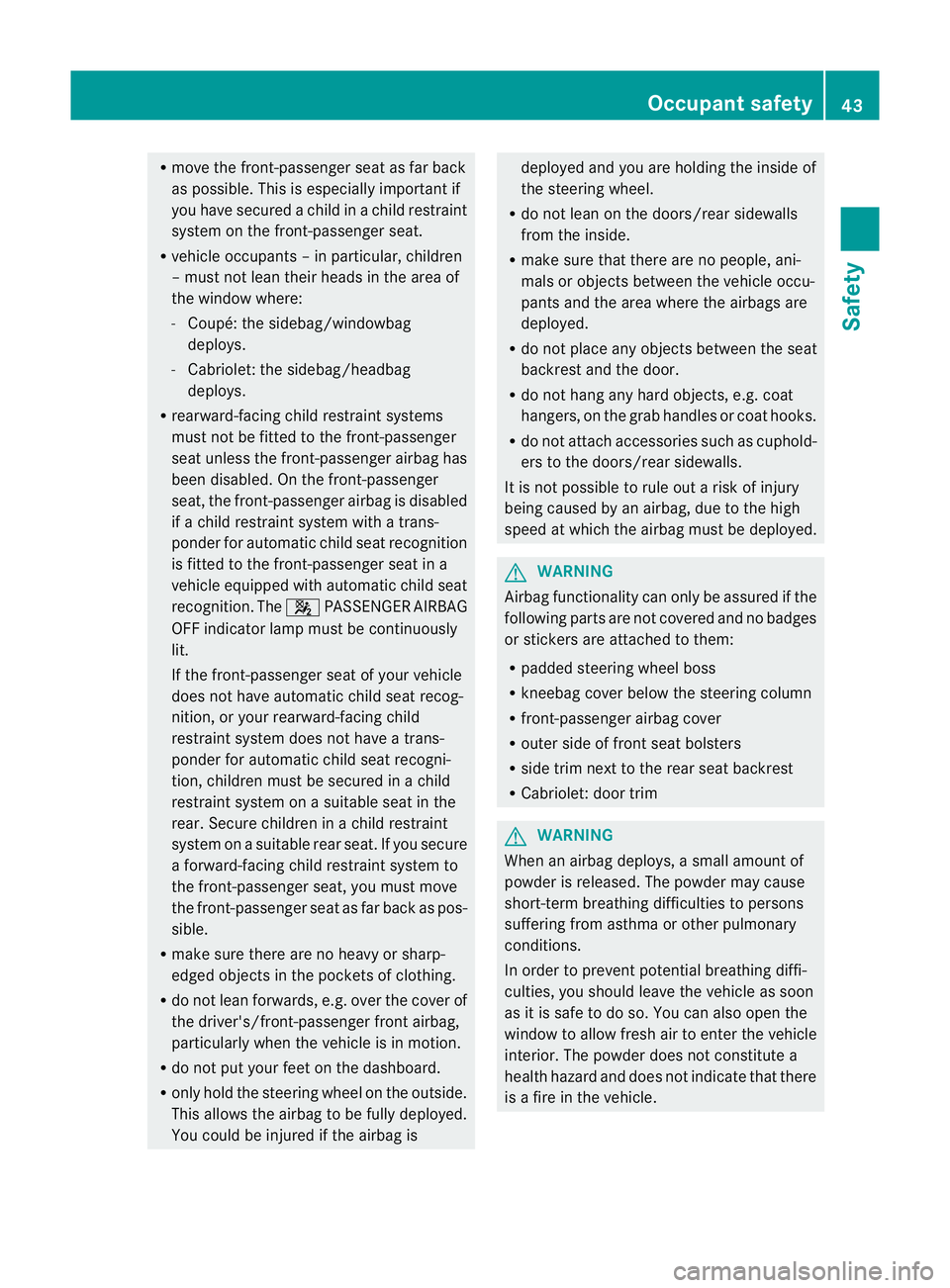
R
move the front-passenger seat as far back
as possible. This is especially important if
you have secured a child in a child restraint
system on the front-passenger seat.
R vehicle occupants –inparticular, children
–m ust no tlean their heads in the area of
the window where:
- Coupé: the sidebag/windowbag
deploys.
- Cabriolet: the sidebag/headbag
deploys.
R rearward-facing child restraint systems
must not be fitted to the front-passenger
seat unless the front-passenger airbag has
been disabled. On the front-passenger
seat, the front-passenger airbag is disabled
if a child restraint system with a trans-
ponder for automatic child seat recognition
is fitted to the front-passenger seat in a
vehicle equipped with automatic child seat
recognition. The 4PASSENGER AIRBAG
OFF indicator lamp must be continuously
lit.
If the front-passenger seat of your vehicle
does not have automatic child seat recog-
nition, or your rearward-facing child
restraint system does not have a trans-
ponder for automatic child seat recogni-
tion, children must be secured in a child
restraint system on a suitable seat in the
rear. Secure children in a child restraint
system on a suitable rear seat. If you secure
a forward-facing child restraint system to
the front-passenger seat, you must move
the front-passenger seat as far back as pos-
sible.
R make sure there are no heavy or sharp-
edged objects in the pockets of clothing.
R do not lean forwards, e.g. over the cover of
the driver's/front-passenger front airbag,
particularly when the vehicle is in motion.
R do not put your feet on the dashboard.
R only hold the steering wheel on the outside.
This allows the airbag to be fully deployed.
You could be injured if the airbag is deployed and you are holding the inside of
the steering wheel.
R do not lean on the doors/rear sidewalls
from the inside.
R make sure that there are no people, ani-
mals or objects between the vehicle occu-
pants and the area where the airbags are
deployed.
R do not place any objects between the seat
backrest and the door.
R do not hang any hard objects, e.g. coat
hangers, on the grab handles or coat hooks.
R do not attach accessories such as cuphold-
ers to the doors/rear sidewalls.
It is not possible to rule out a risk of injury
being caused by an airbag, due to the high
speed at which the airbag must be deployed. G
WARNING
Airbag functionality can only be assured if the
following parts are not covered and no badges
or stickers are attached to them:
R padded steering wheel boss
R kneebag cover below the steering column
R front-passenger airbag cover
R outer side of fron tseat bolsters
R side trim next to the rear seat backrest
R Cabriolet: door trim G
WARNING
When an airbag deploys, a small amount of
powder is released. The powder may cause
short-term breathing difficulties to persons
suffering from asthma or other pulmonary
conditions.
In order to prevent potential breathing diffi-
culties, you should leave the vehicle as soon
as it is safe to do so. You can also open the
window to allow fresh air to enter the vehicle
interior. The powder does not constitute a
health hazard and does not indicate that there
is a fire in the vehicle. Occupant safety
43Safety Z